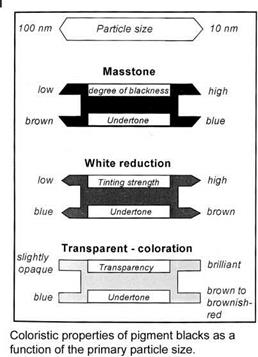Thanks to its excellent properties, pigment black is the most frequently used black pigment in the paint and coatings industry. The following special behavior of these pigments makes it suitable for nearly all coatings applications, from deco systems to the highly sophisticated automotive topcoats:
— Outstanding coloristic, from just black to deep black with blue or brown undertone
— High tinting strength, special tinting blacks show no flooding
— Good alkaline — and acid resistance, makes them suitable in water-based coatings
— Excellent weathering resistivity
— Wide range of comparable products, specialities e. g. conductive black pigments
One technical application parameter, which is important for evaluating the right quality for the right application, is the average primary particle size, expressed in nanometers or microns. A second parameter is the surface chemistry expressed in the value of volatile matter determined by 7 min at 950 °C in % (DIN 52552).
In most cases, the pigment blacks are chosen from a coloristic point of view. In this regard, the most important differentiating property for pigment blacks is the average particle size. The attainable jetness of a coating is determined in principal by the average size of the primary particles. Hence, the smaller the particle size the deeper the jetness. Figure 4.9 explains the coloristic properties of pigment black as a function of primary particle size.
By means of an oxidative aftertreatment to which the pigment blacks are subjected, the processing and technical application behavior is improved compared to non-oxidized products. They fulfill the practical demands to a greater extent. The following properties are improved: dispersion behavior, rheology (especially in the millbase), jetness, undertone, flocculation stability, gloss, and resistance to weathering.
Because of their small particle size and their resulting large surface area, pigment blacks are classed as pigments, which are more difficult to disperse. Depending on the supplied form, pigment blacks can be dispersed with all grinding machines, for example sand mill, pearl mill, ball mill, triple roll mill and others.
Of decisive importance for the efficiency of dispersion is the formulation of the mill base of a coating, which must be composed differently for the various dispersing machines. Depending on the wetting properties of the resin, the preferred binder concentration used is 30-50% and the pigment black concentration, calculated on
Fig. 4.9 Coloristic properties of pigment blacks as a function of the primary particle size.
 resin solid is 12-20% for fine particle size carbon blacks and up to 100% for typical tinting pigment blacks.
resin solid is 12-20% for fine particle size carbon blacks and up to 100% for typical tinting pigment blacks.
The final pigment black concentration to produce a good opacity is 2-5%, for base coats up to 10%, calculated on resin solid. Pigment blacks with extremely high — structure and surface area can be used for electro-conductive coatings [4.27, 4.29]. The carbon black content in this case is 30-50% on resin solid.
4.7.2.4
Pigment Blacks for Plastics
Unlike other pigments, carbon black used in plastics does not only yield coloristic effects but also modifies the electrical properties, provides heat and UV resistance, and may act as a filler to modify mechanical properties.
 7 декабря, 2015
7 декабря, 2015  Pokraskin
Pokraskin  Опубликовано в рубрике
Опубликовано в рубрике 